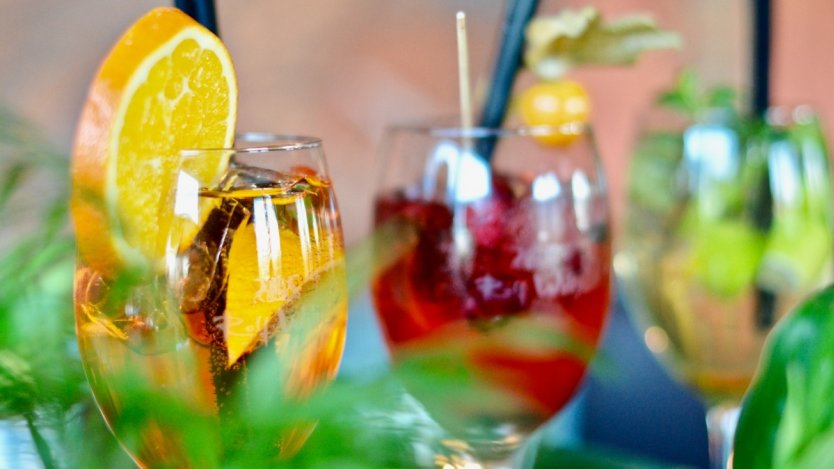It may be the end of August, but rest assured, summer is not over yet. With a plethora of stone fruits and berries still available at farmers’ markets across the country, there’s no better time to make sangria than the present.
Variations of sangria with white wine
White wines are far from being one and the same, so the sky is the limit when it comes to white sangria that can be made from a plethora of different varietals. Four of the most popular white grapes are chardonnay, sauvignon blanc, pinot gris/grigio, and riesling, but they all have very different flavour profiles that lend themselves to different sangria combinations.
Chardonnay tends to be full-bodied, with notes of vanilla and butter, although that also depends on whether or not it has been oaked. Sangria typically calls for something a bit lighter, so finding an un-oaked Chardonnay with a bit more acidity (think green apple) is a solid bet. You can add in kiwis, melons, and even some white rum if you really want to get the party going.
Sauvignon blanc is known for its range of flavours, but screams citrus, so that’s always a good place to start. However, you also want to make sure you balance out all of that acidity with something a bit sweet. Keeping with the citrus theme, you could go for orange juice, or give it a tropical spin with mango or pineapple juices. Fresh herbs like basil or mint would also add some herbaceousness.
Pinot gris and pinot grigio are made from the same grape, but in a different style, rendering one a bit fuller-bodied and the other a bit lighter-bodied, respectively. If you’re working with a crisp pinot grigio, then apples and apple juice are a nice complement, as well as a touch of ginger. Play on the subtle spiciness of pinot gris by adding some sliced jalapeno to your sangria for a bit of a kick.
Riesling usually has quite a bit of sweetness in it, so depending on the type you get, you don’t want to be loading up on heavily sweetened fruit juices or sodas in your sangria. Try adding cranberry juice or even rhubarb to help cut the sweetness with some acidity. Riesling can also have some floral notes, which are complemented well by fruits like peaches, apricots, or nectarines.
Variations of sangria with Vinho Verde
As an important side note to all of the white wine variations described above, one cannot forget the merits of Vinho Verde when concocting choice sangria. This young, Portuguese wine is very low in alcohol (read: incredibly quaffable) and lends a lovely effervescence to the mix. With that in mind, the best way to go is to keep it simple and light. Add in some halved green grapes, maybe a white peach or two, and finish off the works with a splash of soda water or lemon-lime soda. Sangria isn’t complicated to begin with, but this version is about as easy as it gets.
Variations of sangria with rosé
Most rosés tend to evoke flavour profiles reminiscent of their various pink colourations. Some are lighter with notes of fresh strawberry and watermelon, whereas others are more robust and smack you in the face with cherry and other stone fruits. It all depends on varietals used to make said rosé, and the amount of skin contact before they are separated out from the rest of the wine. Whereas rosé from Provence tends to be pale pink and delicate, rosé from Tavel is almost magenta and much fuller in body and taste.
All of this is to say that the type of rosé you choose for your sangria really dictates what you should be adding to it. A good rule of thumb is to add in fruits that mimic the tasting notes of the wine itself. Hints of raspberry? Add some raspberry puree and throw in a handful of raspberries to finish. Tastes like watermelon? Add in watermelon juice (straining out the seeds of course).
Here are some suggested combinations:
- Provence rosé, watermelon juice, fresh mint, lemon-lime soda to finish
- Tavel rosé, cherries, fresh blood orange or orange juice, sparkling water to finish
Variations of sangria with red wine
This is the default variation of sangria and is a great way to lighten up red wine (or use up some of your non-favourites) to make it a bit more drinkable in the dog days of summer. It goes without saying that there’s no need to use super expensive wine here. Obviously, you want something drinkable, but you probably shouldn’t cork something that has been sitting in your cellar for years, only to add a bunch of other things to it.
So what wine should you start with? You could stick to its Spanish origins and opt for a good tempranillo or Rioja. That being said, cabernet sauvignon is always a winner and a crowd pleaser. There aren’t really any hard and fast rules; if you’d drink it during the summertime, it’s probably a sound bet for sangria. Just avoid anything too bold and fruity like zinfandel or shiraz.
From there, it’s all about choosing your add-ins. Choose a variety of stone fruits and citrus, and be sure to allow enough time for the fruit and wine to meld together. The best part of sangria is eating the little bits of boozy fruit afterwards, right? Pour in some orange juice and you’re almost there.
Your last big decision is whether or not you want to anchor your sangria with the addition of more alcohol. It’s not really about upping the alcohol percentage as much as it is about adding more nuanced flavours to your sangria. A couple of shots of brandy, bourbon, gin, or liquor of your choice can really up the ante.













